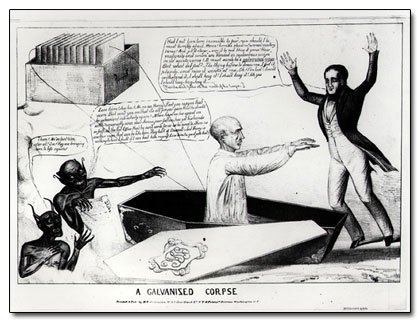We have fictionalized the ‘mad scientist’ through literary works like Frankenstein or movies like Back to the Future in such a way that it’s often difficult to imagine what actually crazy scientists are like.
Yes, crazy scientists exist. And no, we’re not talking about the good kind of crazy. Here are some real examples of scientists (and experiments) who had no qualms with passing on to the dark side. For “science”.
1. Sidney Gottlieb | CIA mind control experiments

If you’ve watched The Men Who Stare At Goats , you might have some faint idea about America wanting to one up the “crazy Russians” in any way possible. Part of the plan was to use mind control techniques for espionage. Sidney Gottlieb was one of the few scientists, who during the 50s, went around the country slipping LSD into people’s drink (yes, rohypnol had a grand dad) to observe its effects on them. He mostly chose hookers and junkies for these experiments but it’s rumored that once, he got an entire town high without telling them what’s what.
2. University of California Scientists | Britches the Monkey

Yes, animal testing might have led to some really important breakthroughs in science but at where does one draw the line between necessity and outright cruelty? In 1985, scientists at University of California experimented on a monkey, named Britches, to test a sonar device for blind people. Britches wasn’t born blind but the scientists sewed his eyes shut and attached a sonar rod to his head. The rod emitted a high pitched noise at regular intervals.
3. Harry Harlow | Pit of despair

American psychologist, Harry Harlow, used Rhesus monkeys to study the impact of isolation and loneliness, hoping to apply his findings to the field of child development and depression. Baby monkeys were taken from their mothers and left caged in a contraption created by Harlow called the ‘Pit of despair’ (0 points for subtlety), in complete isolation. The monkeys became depressed and later developed physical problems.
4. The US Public Health Service | Tuskegee Syphilis Experiment

Between 1932 and 1972, the US Public Health Service knowingly injected African-American sharecroppers with the syphilis virus in rural Alabama. They wanted to study the effects of venereal disease and to do that, the state was willing to sacrifice human lives. Even when penicillin was found to be one of the treatments for Syphilis in 1940, these people were not given access to it. Dr. John Heller, one of the physicians overseeing all of this had this to say about the population that was being experimented on – “The men’s status did not warrant ethical debate. They were subjects, not patients; clinical material, not sick people.”
5. Vladimir Demikhov | Two-headed dog surgeon

The pointlessness of this experiment makes this one of the worst ones on this list. Russian surgeon, Vladimir Demikhov tried creating a two headed dog by grafting the upper half of a puppy to the neck of a fully grown German shepherd. Needless to say, both dogs quickly died as the tissues rejected the transplant.
6. Giovanni Aldini | Reanimated corpses using electrocution

No, necromancy is not simply a skill you master in an Elder Scrolls game. Some people are so obsessed with reanimating the dead, they actually used science to move towards desired results. In 1803, Italian scientist, Giovanni Aldini, subjected the corpse of a convict to electric shocks in presence of a live audience. The shocks vigorously moved the limbs of the corpse, something that scared the shit out of the people.
7. Stubbins Ffirth | Vomit drinker extraordinaire

In the early 19th century, a trainee doctor named Stubbins Ffirth, tried to prove that yellow fever isn’t contagious. To do so, he started experimenting on himself. He used to smear bodily fluids of yellow fevers patients on his own body. Later, he went even so far to drink their undiluted vomit (I pause while you cringe). Later, it was found that all of his patients were in the last stages of yellow fever, by which time, they weren’t contagious anymore.
8. Joseph Mengele | Angel of death

Joseph Mengele was an SS physician during WW2, who decided who was to be killed and who was to be pushed into forced labour. But he earned the moniker Angel of Death due to his sadistic experiments on inmates of the concentration camps. He was particularly fascinated by the anatomy of identical twins. In one case, he tried to create a conjoined pair by grafting twin brothers to each other. Not surprisingly, the pair died. Almost all of his experiments on his victims were without the use of anesthesia.
9. Andrew Ure | The corpse puppeteer

While Scotsman Andrew Ure is noted in the pages of history as a doctor, scholar, chemist and a business theorist, he’s also infamous for his experiments on a corpse. He performed the most notorious public demonstration on a hanged man. He felt life could be restored through the proper kind of stimulation. He applied electrical probes directly to the muscle through incisions in the flesh. When he applied electric current to the body, the corpse’s eyes opened, the face grimaced, and the arms shot up.
10. Shiro Ishii | Director of the notorious Unit 731

Unit 731 was the biological warfare unit of the Imperial Japanese Army and Shiro Ishii was a microbiologist and a lieutenant there. During the Second Sino-Japanese War, he headed the biggest camp of Unit 731 outside the city of Harbin, China, where he performed gruesome experiments on his prisoners. This included vivisection of pregnant prisoners (who were impregnated by the captors), amputation of prisoners’ limbs and then re-attaching them to other parts of the body, using live humans to test the impact of flamethrowers and grenades, injecting them with disease causing viruses under the guise of vaccination, deliberately infecting both male and female prisoners with syphilis and gonorrhea through rape… yeah, that’s a long, sadistic list. And guess what? Thanks to the immunity offered by the American Occupation Authorities (who really wanted Japan to not give in to Soviet communism), Ishii was never convicted for his war crimes. He died at the age of 67 due to throat cancer.

















